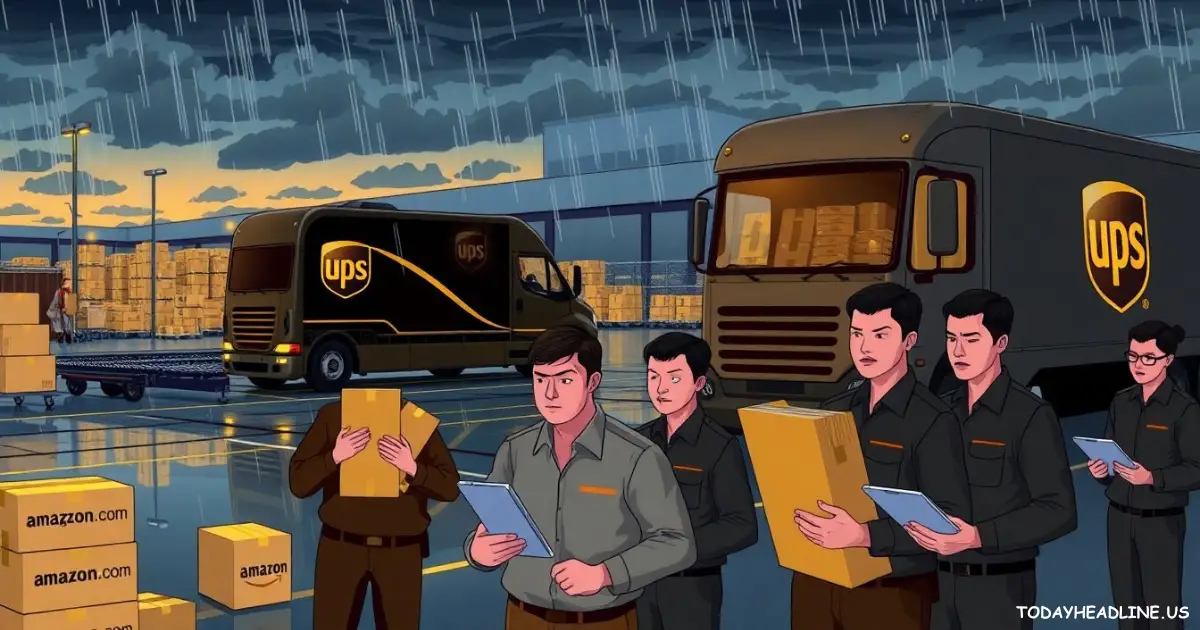Big changes are happening at UPS. The company just announced it will cut 20,000 jobs. This move comes as UPS reduces its business with Amazon. The shift is a sign of big changes in the logistics and online shopping world. For years, UPS relied heavily on Amazon as a major client. Now, with less business from Amazon, UPS faces new challenges. This decision will affect workers, the supply chain, and other delivery companies. It’s a story worth watching. It shows how e-commerce companies are changing delivery services and how companies like UPS adapt or struggle.
UPS’s Strategic Business Adjustments and Amazon Relationship Decline
Background of UPS and Amazon Partnership
UPS used to be Amazon’s main delivery partner. Amazon depended on UPS to deliver millions of packages. This long-term relationship started around a decade ago. Over time, Amazon became one of UPS’s biggest clients. Their partnership helped UPS grow steadily, especially during online shopping surges. Amazon’s reliance on UPS made the logistics giant a key player in e-commerce deliveries.
Reasons Behind the Reduced Business with Amazon
Recently, Amazon decided to build its own delivery network, called Amazon Logistics. This move lets Amazon ship packages without relying on big carriers. Amazon’s strategy puts less demand on UPS and other traditional couriers. At the same time, Amazon wants to cut costs and gain more control. UPS faces pressure to become more efficient and profitable. Industry trends show that more companies are trying to manage their own supply chains and cut out middlemen. As a result, UPS’s dependence on Amazon has dropped sharply.
Impact on UPS’s Business Performance
Less volume from Amazon hits UPS’s revenue. Financial reports show that UPS’s earnings faced some decline after Amazon cut back. This isn’t unique; other carriers are seeing similar trouble when they lose big clients. It’s clear the loss of Amazon’s business affects UPS’s bottom line. The company must find new ways to grow and stay competitive without relying so much on big clients like Amazon.
The Workforce Impact: Layoffs and Workforce Strategy
Details of the Planned 20,000 Job Cuts
The layoffs include drivers, warehouse workers, and administrative staff. UPS plans to cut roles in many parts of the country. The job cuts will happen gradually over the next few months. The company says the goal is to adjust to lower package volume and improve efficiency. Not everyone will lose their job forever, but many will face temporary or permanent layoffs.
Broader Implications for UPS Employees and the Job Market
Massive layoffs hit workers hard, especially those who work in delivery and warehousing. The immediate effect is fewer jobs for drivers and warehouse staff. Long term, workers need new skills to find other jobs. UPS might offer training or reskilling programs. Labor experts warn that big layoffs like this could slow down job growth in the delivery sector. Still, it might push workers to learn new skills for different roles.
Company Statements and Industry Reactions
UPS CEO released a statement saying the layoffs are necessary to adapt to changing business needs. Labor unions expressed concern about job security. Industry analysts see this move as part of a larger trend. Many delivery companies are shifting direction. The layoffs emphasize the ongoing challenges facing the logistics industry.
Broader Industry and Market Impacts
Shifts in the Logistics and Supply Chain Industry
This decision reflects how e-commerce continues to grow, but in different ways. Companies are trying to control their own shipping. FedEx and DHL are also adjusting to similar trends. Major clients like Amazon are building their own delivery systems. This shift could reshape the entire logistics industry.
Economic and Consumer Market Effects
Lower delivery costs could be one result. But service levels might change too. Delivery times could slow down or prices could increase. Shoppers might notice changes in how quickly their packages arrive. These shifts could influence online shopping habits and the growth of e-commerce. Future logistics companies will need to stay flexible and adapt quickly.
Regulatory and Policy Considerations
Big layoffs may attract government attention. Regulators may look into how large companies are managing their workforce. Policy changes could come to protect workers or regulate logistics restructuring. Staying aware of these rules is key for companies plotting future moves.
Actionable Insights and Future Outlook
Strategic Tips for Logistics Companies
Diversify your customer base to avoid over-reliance on one client. Use technology and automation to cut costs. Plan for flexible staffing that can adjust with demand. Innovation is key to staying ahead.
Recommendations for E-commerce Retailers
Build more than one logistics partnership. Relying on a single provider creates risks. Keep supply chains flexible and ready for sudden changes. Stay alert to industry shifts to adjust your shipping plans quickly.
Future Projections for UPS and the Logistics Sector
The industry will continue to see disruption as large firms develop their own logistics networks. UPS and others might look for new markets or services to grow. Companies that innovate and stay flexible will find new opportunities. Expect ongoing changes, with some traditional carriers shrinking and others evolving.
Conclusion
The decision for UPS to cut 20,000 jobs and reduce Amazon business is a wake-up call. It shows how fast the logistics world is changing. Companies need to adapt, innovate, and plan for the future to survive. As online shopping grows, logistics providers can’t stay still — they must change or fall behind. For workers, new skills will be key. For businesses, diversifying shipping options can make a real difference. The logistics industry is shifting, but opportunities remain for those who stay creative and ready.

